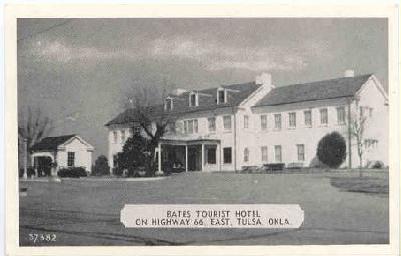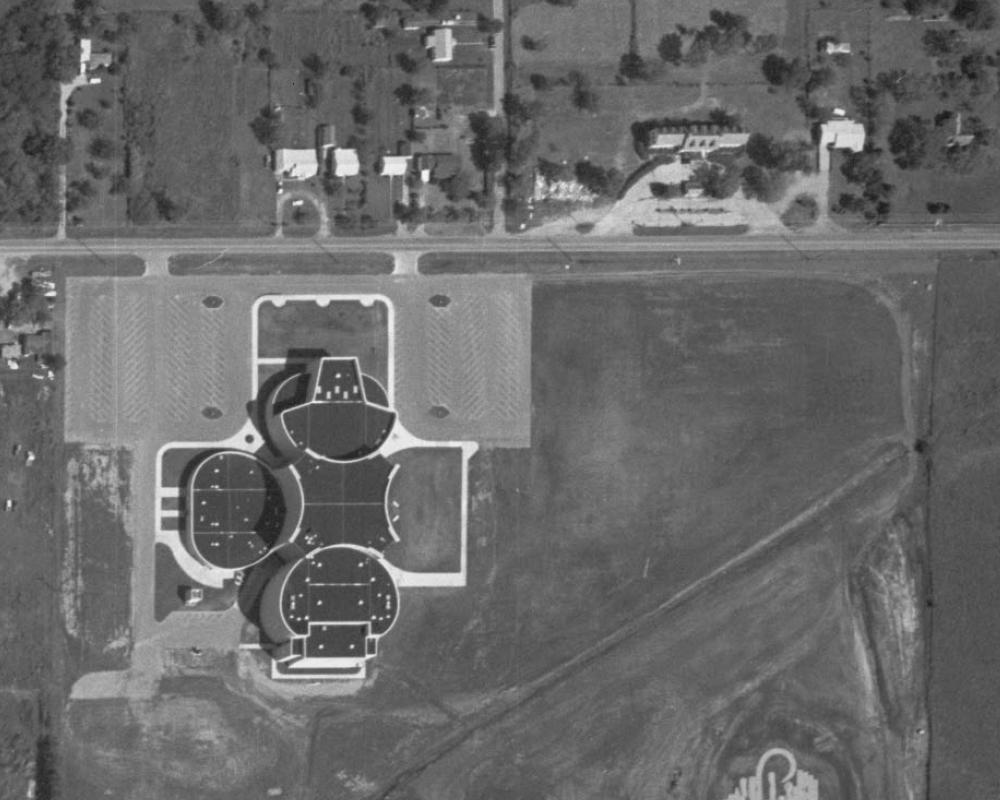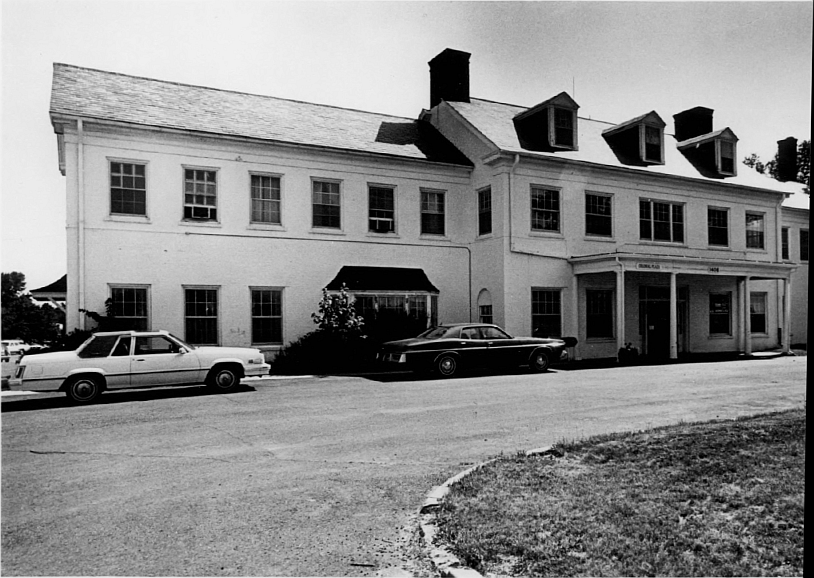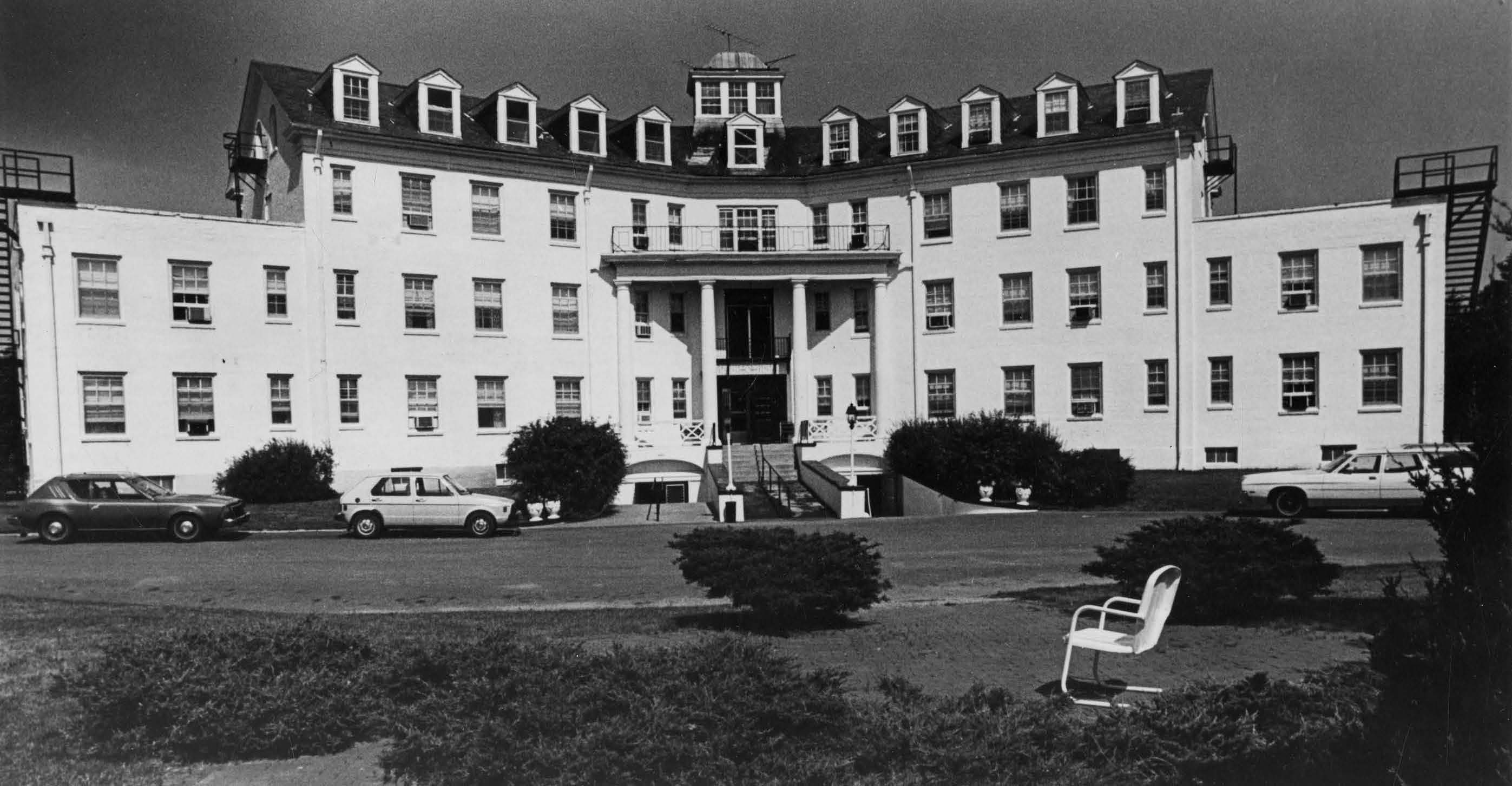Bates Motel really existed (sort of), right here in Tulsa
 (Image originally from AlanOfTulsa on fotothing.com; direct link to photo.)
(Image originally from AlanOfTulsa on fotothing.com; direct link to photo.)
One more Route 66 related entry. Someone called alanoftulsa posted this postcard with the following info on the TulsaNow forum. The doings at cousin Norman's place almost sound tame compared to the real-life Bates Tourist Hotel.
Because of the conditions of family life, my parents ended up bankrupted. The Sheriff's department came out one evening to repo the furniture. While they were there, my dad and a Deputy got into a conversation about the Bates hotel which used to be across the street from East Central High School on 11th street. I was very familiar with this hotel because as a kid I explored the dilapidated hotel several times. It was a really scary place to explore and as kids we usually ended up running out of it thinking that someone hiding inside and was after us.The Deputy told us that the Bates Hotel was used by Gangsters traveling down route 66 because it set just outside the Tulsa city limits where they didn't have to worry about Tulsa Police. He said that one night some of these gangsters got into a shoot-out inside the hotel and killed the hotel manager's daughter. He also stated that there were more bad things than that going on in the Bates. Does anyone know of any stories about this Hotel?
I remember having seen the Bates Hotel listed in the yellow pages of an old Tulsa phone book, but it was listed as merely being "E of City" -- no specific address. I had always wondered where it had been and what it had looked like.
So does anyone else have stories about this place? Anyone know when it closed, and when it was finally demolished?
By the way, that same forum entry included a mention of another place I had always been curious about. I passed it thousands of times and always wondered why there was a white-painted two story brick building in the middle of nowhere, just south of Admiral Place and 165th East Ave. The building was dressed up as a bar for the movie The Outsiders and was demolished some years later. alanoftulsa says it was the Rose Dew Egg Farm, and he lived there. Evidently the farm gave its name to the subdivision built around it (or likely on land that once was part of the farm). I'd be interested to know more about this place as well.
UPDATE November 22, 2014:
The 1967 USGS aerial photos of Tulsa still show the Bates Tourist Hotel, located on the north side of 11th Street, across from the present-day location of the East Central High School football stadium. An interesting detail not revealed by the postcards: The building had nine dormers on the north side -- three corresponding to the three dormers above the main entrance, and three each on the west and east wings. That may indicate the number of rooms available upstairs. Based on the scale of the photos, the building appears to be about 140 feet long and only about 25 feet deep. The rooms must have been tiny, and it's likely that they were not (at least not originally) en suite.

About a month ago, my son and I were returning from a two-week car trip to visit colleges. We stopped just west of St. Louis at the visitor's center for Missouri's Route 66 State Park. The visitor's center has photos and artifacts highlighting the landmarks on the Show-Me State's section of the historic road, including the Coral Court Motel, the various caves on the route, the town of Times Beach, and Campbell's 66 Truck Lines ("Humpin' to Please"). (They also had a display of Buffalo Ranch memorabilia.) One display stopped me short:
The architecture was familiar -- the prominent dormers -- and the caption on postcard at the top said that there was a Sinclair Pennant Tavern on U. S. 66 in Tulsa, Okla. The Sinclair Pennant chain was originally known as Pierce Pennant. The Route 66 News review of the book Route 66 Treasures mentions that the Pierce Pennant chain "sought sites every 125 miles on the fledgling U. S. 66."
Sure enough, it appears that the Bates Tourist Hotel was originally a Pierce Pennant Tavern. The 66postcards.com website, which arranges postcards and other photos from the route in sequential order from east to west (with impressive accuracy, even within cities), has three views of the same hotel: A postcard of the Tulsa Pierce Pennant Terminal, a photo of the Tulsa Pierce Pennant Motel (from the Beryl Ford Collection), and the above postcard of the Bates Tourist Hotel. The vegetation has changed, but the fenestration is identical.
The caption on the Pierce Pennant Terminal postcard reads (in neat copperplate type):
A Terminal Building and Filling Station Island of Pierce Pennant Terminals System
Facilities include: 154-person restaurant, women's rest room, soda and sandwich lobby
emergency hospital
Interesting that initially it isn't called a hotel, but a "terminal" and later a "tavern."
This page, showing a photo of Pierce Pennant china, says that the company opened its first motor hotel in Springfield, Mo., in 1928, but by 1930, they had sold the chain to Sinclair. "This first motor hotel complex included a bus terminal, restaurant, soda fountain, restrooms, gas station, automobile shop and car washing facilities." This picture of the Springfield Pierce Pennant terminal looks more like a bus station and gas station.
The Pierce Pennant Hotel in Columbia, Mo., was nominated to the National Register of Historic Places in 1982. The main hotel building still stands at 1406 W. Business Route 70 and is part of the Candlelight Terrace Retirement Center. The hotel, which opened in 1929, was built to high standards (slate roofs, copper on the cupola, piers down to bedrock, metal laths under plaster for interior walls, solid brass light fixtures, "recognized by contractors as one of the best constructed buildings in the Columbia area)."
The National Register application for the Columbia Pierce Pennant Hotel mentions a separate "terminal building" with a description that sounds very much like the above Tulsa post card. The description of the windows is an exact match.
The second major building of the Pennant complex, originally known as the Terminal, is of the same general colonial style as the hotel-garage. It has two stories and an attic. The overall dimensions are ninety feet by thirty-five feet. The building consists of a central section, with wings on the east and west wings have six windows. The lobby section has four windows and a doorway on the first floor and five windows on the second floor, the window above the entrance being of the same width as the first floor doorway. A small portico shelters the entrance to the lobby. The attic has three dormer windows, facing north. On the roof are three chimneys; the extra chimneys were possibly connected to the operations carried on in the kitchen area.Just off the lobby were restrooms for men and women. An emergency hospital with a trained nurse on duty was contiguous to the women's restrooms. On the second floor was a large dining room sixty-two feet by forty feet and an auxiliary dining area forty feet by twenty-three feet. Folding doors, which could be opened to provide space for a large group of diners or for a dance party, separated the two dining rooms. The kitchen was just west of the dining section. The third floor was occupied by employees of the terminal.
There is a photo of part of the terminal building on page 19 of the application:

At some point, it would seem, the hospital and dining areas in the Tulsa Sinclair Pennant Tavern were converted to motel rooms.
UPDATE 2015/12/03: Reader Kevin Gray writes that the next Pierce Pennant up Route 66, on the north side of Miami, OK, was used during World War II as offices for the British Flying Training School #3, which was operated by Spartan. "The old motel was offices, and barracks were built behind and around it. The athletic fields were behind the barracks, and the airfield, runway and hangars were immediately behind the athletic field." More about the Miami Royal Air Force school here. 15 RAF cadets are buried at Miami's Grand Army of the Republic Cemetery and are honored in an annual remembrance ceremony. More here about World War II RAF training schools in Oklahoma.
UPDATE 2021/02/09: A new article on Miami History provides a detailed contemporary description of the Miami Pierce Pennant Terminal as it was under construction in the summer of 1929, as well as a photo of the building when it was in use as a flying school during World War II, and finally a color photo of the building as Winart Pottery in 1955. The newspaper article from the Sunday, July 21, 1929, edition of the Miami Daily News Record describes both a pattern for a 40-room four-story hotel building and the terminal building. The general plan was to build the terminal, then add 40-room hotel units around the 10-acre landscaped parcel to meet local demand. Initially, only Columbia and Rolla, Missouri, locations were to have hotel units. At the time of the article facilities were open in Springfield and Rolla, under construction in Columbia, Miami, Tulsa, and Oklahoma City; Amarillo and some city between Amarillo and Oklahoma City would be the next projects started. Pierce Pennant had ambitions of a location every 125 to 150 miles along US 40 and US 66, the two major cross-country thoroughfares.
Here is the description of the terminal, quoted from the May 11, 1929, issue of Tavern Talk:
"Upon alighting from his automobile under a massive white pillared canopy and entering the spacious doors of the terminal, the visitor will be immediately impressed by the depth of the main waiting room. Depending upon the season, his senses will react to its cool coziness or satisfying warmth. In the chill days of late spring or early fall, he will find an open fireplace at the end of the room, logs blazing merrily, just the tang of wood smoke redolent of the Ozark backwoods hanging in the air, inviting a relaxing "stretch" before its hearth. Summer, with its heat and glare and dust, is quickly transformed by the refreshing coolness of the well ventilated lounge, huge ceiling fans silently wafting synthetic lake breezes to the massive and comfortable divans and easy chairs. This room is 50 feet long and 35 feet wide, backed by a soda fountain for soft drink and sandwich service, with tables and chairs to accommodate 50 guests."To the left of the main waiting room will be three rest rooms for women. The first is a French renaissance room, oddly in contrast to the Colonial simplicity of the public lounge, yet peculiarly appealing in the loveliness of its feminine appointments. Then comes the women's toilet, the floors of which will be inlaid rubber and walls finished in white marble and chromium. To the left of the French room is an emergency hospital equipped with three hospital beds, with white tables and chairs to match, and three trundle beds for infants. In the center is a standard hospital operating table, so arranged that normally it assumes the appearance of an ordinary table. A cabinet containing all the surgical instruments, supplies and appliances necessary for an emergency operation is placed in the wall. This room has a large double door, so that an ambulance may have easy access. A trained nurse will be in constant attendance. Either sex may receive treatment here.
"To the right of the main waiting room will be the men's toilets, as elaborately equipped as those for the women. In addition to the manager's office, a special dining room and toilet for negro chauffeurs is also at this side of the main floor.
"Ascending the winding stairway, rested and refreshed, the visitor seeking satisfaction for the inner man will find awaiting him a modern dining room that for service, cuisine and appointments will be on par with the larger hotels of the country. With a seating capacity of 100 diners, this room is so built that one-half of it may be closed off to accommodate bridge luncheons and club dinners. Music, when desired, is convenient, as the facilities include a Victrola, radio and grand piano, and the entire spacious dining room is available for dance purposes. A modern and compact kitchen is situated at the rear of the dining room.
"In addition to the heating and refrigerating apparatus, the basement is equipped with a modern steam laundry, insuring clean linens at all times for dining service and clean, freshly laundered uniforms for waitresses and attendants."
Earlier, in the description of the hotel rooms, the article says:
"The Pierce corporation invites guests to do such washing as they care to do in their rooms, and has provided the proper facilities for them. In the clothes closet of each room has been placed an electric drier, a folding ironing board and an electric iron."In the basement of each terminal building is a modern steam laundry for laundering the linen of the terminal and hotel buildings. This laundry will work nights and tourists delivering their laundry to hotel employees before 9:00 p.m. can have it returned to them any time they desire after 4 a.m. the next morning.
The hotel building plan called for parking on the "fire" floor, 16 rooms each on the 1st and 2nd floors, 8 rooms on the 3rd floor, and 5 rooms without bath on the top floor for chauffeurs. The 40 standard rooms were to be 16' x 12' with two double beds.

This plan seems to have been realized at the Columbia location, as evidenced by the NRHP application, and in Rolla, as noted in the display above from Route 66 State Park in Missouri, but nowhere else. The 16 rooms on each of the first and second floors appear to have been arranged with six on each of the two main wings and four on the back wing.
After serving as a branch of Stephens College during World War II to train female pilots and ground personnel, in 1959, the Columbia hotel became Candle Light Lodge retirement center, and is still in use today as Candlelight Lodge Assisted Living.
MORE 2024/05/28:
Rolla's Pierce Pennant Hotel was on the east side of North Bishop Avenue (Old Route 66), just north of present-day I-44, roughly where the Steak'n'Shake is now located. It was later known as Carney Manor Inn or Manor Inn. The Springfield Pierce Pennant Terminal was a single-story California Mission-style building that served as the Greyhound Bus Terminal from 1936; it was torn down in 1979.
A feature photo in the December 29, 1946, Tulsa World reported:
WHITE-ELEPHANT TAVERN IS SOLD: Sinclair Pennant Tavern, long-time white elephant of the Sinclair Oil Co on Highway 66 east of the city, will be converted into a tourist hotel within the next few months, Frank Bates, new owner, has announced. Opened in the lush 20's by the Pierce Oil Co., the tavern was a roadside eating place complete with hospital and lounges but was abandoned in 1935 by Sinclair and has been boarded up and vacant for the past 11 years. Bates will convert it into a 20-room tourist hotel, complete with lounge, restaurant and trailer camp. The elaborate restaurant refrigerating and other equipment will be sold and moved out to make way for the new Bates Tourist hotel, expected to be in operation by late spring.
In 1948, the Bates hotel was a polling place. Frank Bates and his wife Kathy Mae celebrated their 50th wedding anniversary in 1956. Frank died in 1962 at the age of 75. He was born in Excelsior Springs, Missouri, farmed in Wagoner County (Blue Mound township), moved to Tulsa in 1935, worked for Hawk Dairy, then bought the Bates hotel in 1946, retiring in 1956. The 50th anniversary article describes the hotel as having 16 rooms. Frank and Mae Bates are listed on the same page of the 1950 census as future rodeo star Jim Shoulders, then 21, his wife Sharon Lee, and their baby daughter Sharolyn Ellen. It would seem to indicate that the family was living at the hotel at the time of the census.
0 TrackBacks
Listed below are links to blogs that reference this entry: Bates Motel really existed (sort of), right here in Tulsa.
TrackBack URL for this entry: https://www.batesline.com/cgi-bin/mt/mt-tb.cgi/2501

The "[direction] of City" was used in phone books in two instances: when a subscriber was sufficiently rural to be off the street grid, or when a subscriber did not want his address revealed. East Central, if I remember correctly, is on 11th between Garnett and 129th, which is not my idea of rural, so it may be that the Bates folks didn't want to give out any "unnecessary" information. (The Haunted House restaurant in Oklahoma City used to do that, in an effort to get you to call for directions in addition to reservations. It's still not exactly obvious where the place really is, even though they give you the address today.)
I grew up in Tulsa and in my teenage years my friends and I used to go to the Bates Hotel late at night and drink beer and mess around.
This was long after the Bates had closed and the interior had obviously been vandalized. I swear it wasn't us.
It was very spooky but that was part of the appeal for hanging out there. We were more afraid of being caught by a night watchman, or the police, than of any ghosts or poltergeists that might have been there.
I haven't been to Tulsa since I was 19 and I've always been curious if it is still there or not. I'm pretty sure it's probably been torn down by now.
Terry Groff
Dallas, Texas
It's long gone, sadly. About what year was it when you would hang out there?
Mostly it was around '66 - '67. We had a lot of good times there and we were never caught.
My father rented the Phillips 66 station in front of Bates Hotel in the mid 1950's. When I was seven yrs old my grandmother was killed turning into the service station by a dump truck that side swiped her car in 1957. She was a teacher at East Central Elementary School.